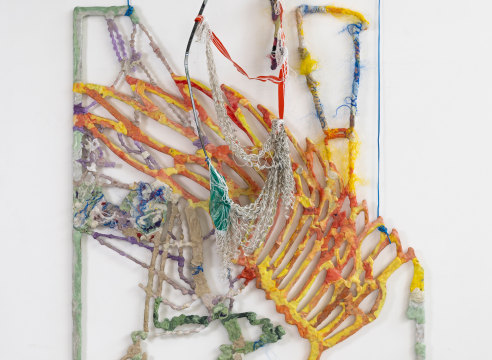

Julien Creuzet is a French artist whose work combines experimental filmmaking, music, sculpture, performance, and poetry. Mixing language, dance, and literature, his output is extensively influenced by the history of decolonization. The title of the exhibition is an extract from a poem Creuzet himself wrote, reflecting on the relationship between peripheries and centers, questioning the idea of time and geographical location as fundamental concepts in understanding cultural production. Reacting against dominant Western narratives, Creuzet looks for inspiration in the legacy of Afro-Caribbean and Creole philosophical thought and literary production. Exploring the ambiguity of representation, identity, the body, movement, and dance as tools for resistance, his intention is to create a meditation on the living spectacle of opera through visual and physical sculptural forms and time-based moving images.
A key influence in the work of Creuzet is the surrealist author and poet André Breton, a seminal figure who played an important role in the re-evaluation of African culture in art history. During the Second World War, Breton emigrated to the United States of America. On his way to New York, he stopped in Martinique. While there, he began exploring the local cultural landscape, which inspired his writing. One of the most significant interlocutors he met in Martinique was poet, playwright, and future politician Aimé Césaire, one of the most influential authors of the French-speaking Caribbean. Breton’s output, questioning the Western canon and complexifying the dominant Western ideology of the time, alongside Césaire’s writings on black identity and the concept of Négritude are pivotal in Creuzet’s work.
Césaire’s thoughts, in particular about creating a more positive sense of humanity through the rediscovery of black cultural qualities and restoring the cultural history of black Africans, were fully expressed in Cahier d'un retour au pays natal (Return to My Native Land). A mixture of poetry and poetic prose, he set about composing it on a small island on the Adriatic coast of Croatia. Seascapes and landscapes, reminiscent of Césaire’s journey to Croatia, are represented in the horizontal screens that illuminate the exhibition space, offering an ever-moving pictorial horizon.
Foregrounding questions of modernity, postmodernity, and contemporary cultural hybridity, the sculptural forms in the exhibition function as an intimate and powerful discovery of many worlds brought together. Images from diverse sources, including historical African sculptures, abstracted landscapes and compositions inspired by engravings and paintings, some referencing the work of painter Wifredo Lam, compose a path between objects and projected images, reflecting on the way that histories can be markers for change and resistance. The exhibition confronts the viewer with questions on the animate and the inanimate linking the enclosed space of the gallery with a larger universe of references. Avatars of dancers performing in different African traditions, including dances from the African diaspora, coupled with enigmatic spoken word poetry and sounds composed by the artist are deliberately informal yet unsettling, and echo the ethics of difference, creolization, and the plurality of thought that is at the core of Creuzet’s practice.
The exhibition is organized by Vassilis Oikonomopoulos, Director of Exhibitions and Programs and Martin Guinard, Curator, assisted by Claire Charrier, Junior Project Manager.